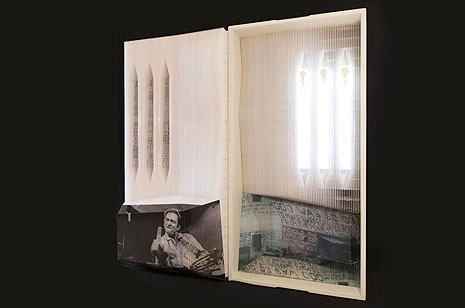
FAYETTEVILLE, Ark. – A box depicting inspiration. That’s what architect Marlon Blackwell was asked to come up with when he got a letter from Billie Tsien and Tod Williams, prestigious New York architects, to participate in the Venice Biennale.
They were inviting 35 select architects from around the world to contribute to the architecture section of the Venice Biennale, for an installation they were curating. The theme was “Common Ground,” seeking commonalities rather than an individual’s design signature.
These were not themselves architectural projects, nor examples of ongoing projects at the firms or studios. They were a method by which designers could express how they think and offer a glimpse at what inspires them.
This was an intriguing idea for Blackwell, Distinguished Professor and head of the architecture department in the Fay Jones School of Architecture.
The 40-by-20-by-10-inch plain shipping boxes could simply be filled with items, or they could become part of the display themselves. A New Jersey woodworker made the boxes, and then Williams and Tsien shipped them to designers at the end of May. Blackwell and his staff at Marlon Blackwell Architect worked this summer on the piece. Blackwell sketched and Justin Hershberger, visiting assistant professor, constantly testing components, as well as others in the firm who contributed. They shipped it to Venice, Italy, in July.
This is the 13th edition of the International Architecture Exhibition, and the exhibition, directed by David Chipperfield, continues through Nov. 25 in Venice.
Blackwell’s process involved introspection and an internal investigation of inspiration. Blackwell, who has lived, practiced and taught for more than 20 years in Arkansas, looked to the state for fodder.
He treated the box as a site. Using both the box and the lid, he married them together to create a diptych. The box, titled “Inflections of Spirit Outside My Window,” serves as a sort of altar, honoring “the things that move me about my place, Arkansas.”
He considered the distinct topographical contrast in the state, and thought of a dialogue between the Ozark and Delta regions. He thought of the long, slender chicken houses that litter the landscape, lit at night like beacons, and the chickens that inhabit them.
Tongue in cheek, Blackwell references the ideas of faith and possibilities in this place. He used three chicken skulls, which represents a trinity on one level. Those skulls are encapsulated in rectangular bars that are squared off at the top, where the skulls rest. Then, the bars gradually taper toward the bottom, where they form the profile of a chicken house with the point of a roof. Those three bars are illuminated with LED lights.
“It has a kind of spiritual and, at times, religious overtone to it,” he said.
Blackwell represents the state’s hills and plains with pieces of translucent acrylic placed on edge in the box. The chicken houses are set into those. Those acrylic ribs also gave the display piece structure so it would survive the transport to Venice.
There is a color photograph of the “God barn,” a barn, now gone, that was painted with passages of scripture. That structure shows reverence for both religious faith and the land. That is contrasted with a famous black and white photograph of Johnny Cash “flipping the bird,” which showed an irreverent spirit of the land, a rebel spirit of the people and place where Cash hailed from, Dyess, Ark.
The piece features a beat-style poem written by professor David Buege from a slew of words Blackwell provided about this place. It references the agriculture, mountains and rivers, religion and music of the state.
That poem, printed in color, with the words in fonts of varying sizes, covers the inside of the lid. It peeks out through three slits in the terrain of vertical acrylic pieces; those three slits are the negative footprint of the chicken house. When the box is together, they fit perfectly.
Blackwell used words and images that speak to transformation, reverence and irreverence. The piece speaks about the transformation of the land and the change embedded in the land.
“To me, inspiration comes from negotiating between these ideas about reverence and irreverence and being inspired by things you find in your place, but also by literature, scripture, music – all of those things that represented this place,” he said.
The Cash photo was integral to this piece. For that photo, taken in 1970 before a performance at San Quentin Prison, Blackwell negotiated with the family of the late music photographer, Jim Marshall. The Marshall family hadn’t licensed the photo for any projects since his death two years ago, and Blackwell convinced the family’s representative to let him use it. He did pay a fee – not for the artwork, but for its publication in the book that will be produced about the exhibition.
Williams told Blackwell that the quality of the collective work for this exhibit is even beyond what they expected. It’s revelatory about how the designers think and about the nature of inspiration.
Over the past two decades, Arkansas has become the source of Blackwell’s design inspiration. Increasingly, his inspiration has been informed by the spirit of the music, of the land, the vernacular, a struggle between that reverence and irreverence. “It becomes a part of you,” he said, “rather than it just being a setting for you.”
This exercise was like a reconnaissance mission into the past, something that’s necessary to do but hard to describe. “It embodies a lot of what motivates you as a designer, or just what motivates you in life in general,” Blackwell said. For him, that means being in a place and of a place, but at the same time “maintaining a kind of critical perception, so it’s not just a romantic notion or nostalgic notion of it.”
Contacts
Michelle Parks, director of communications
Fay Jones School of Architecture
479-575-4704, mparks17@uark.edu